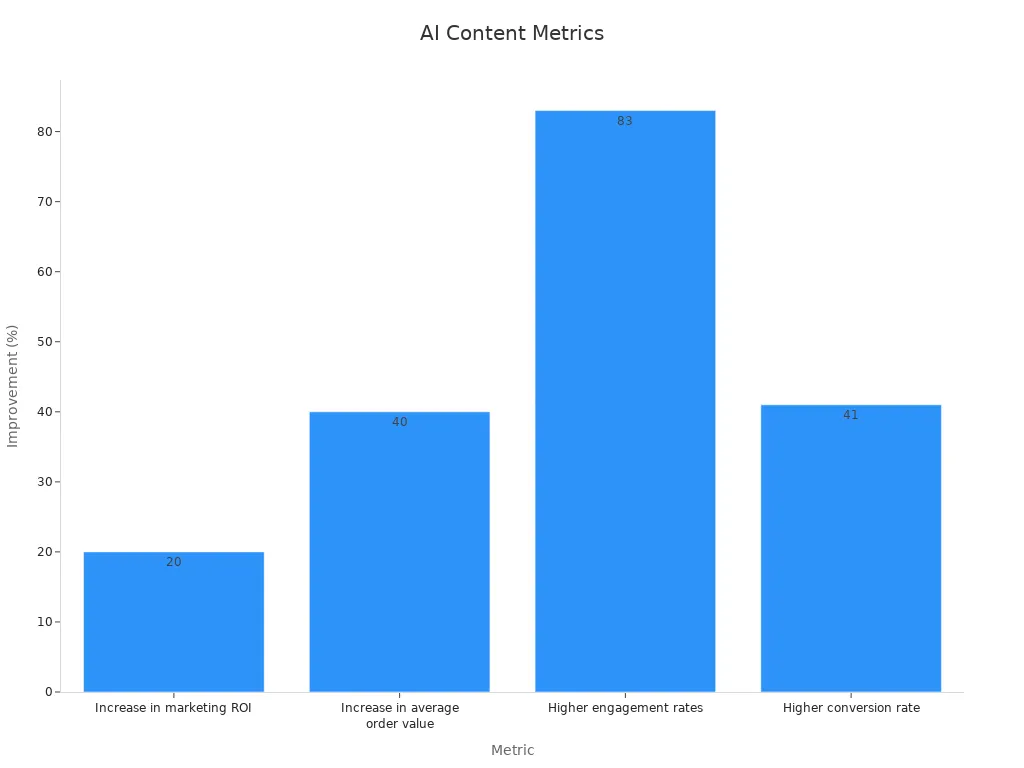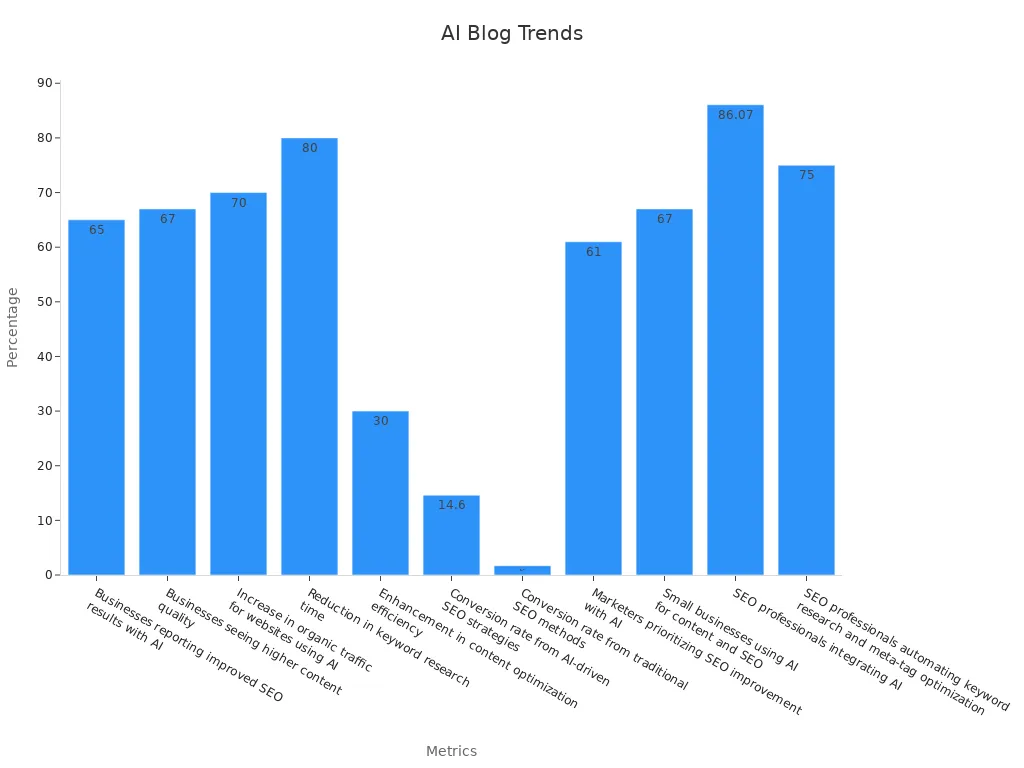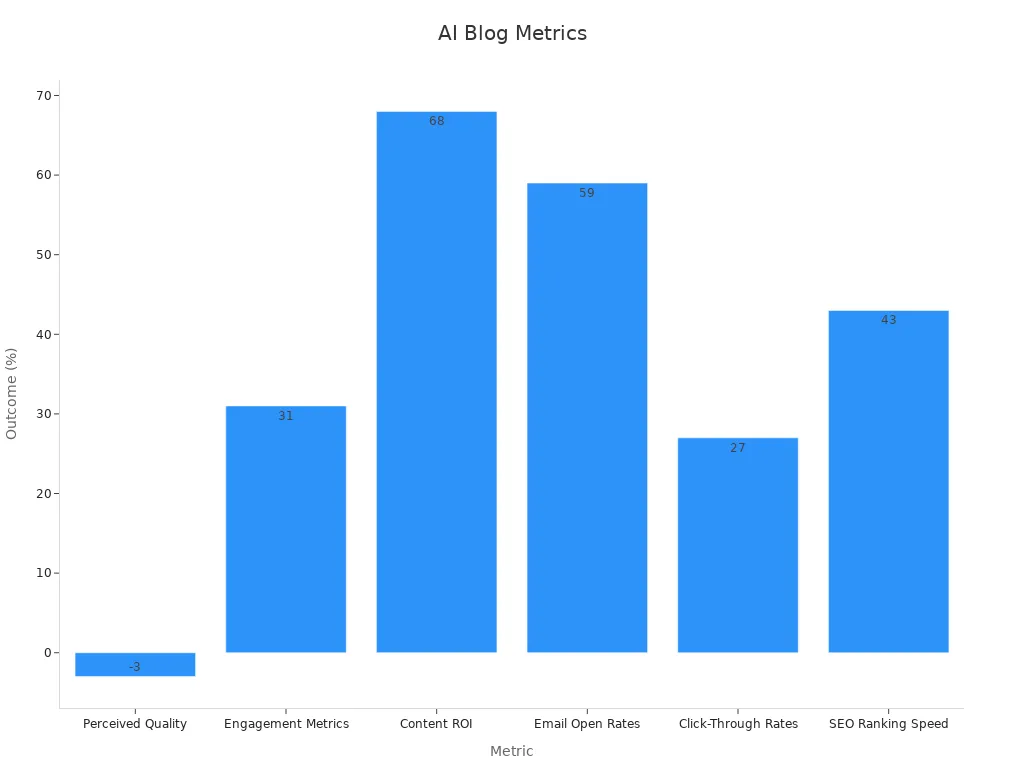How AI Enhances Lead Generation Through Blogs

Imagine a tool that helps find the best readers for your blog. It also creates messages that feel special for each person. This is how AI enhances lead generation. It handles boring tasks like finding new leads and making content personal. This saves you time and energy. Companies using AI see over 50% more ready-to-buy leads and spend 60% less on finding leads.
AI is becoming more important in online marketing. More than half of companies now use AI to work smarter. Many are learning even more ways to use it. Adding AI to your blog plan can change how you reach people and get results.
Key Takeaways
AI finds leads faster, saving time and targeting interested readers.
AI creates custom content, keeping readers engaged and coming back.
Predictive tools guess what readers like, making content more useful.
AI handles boring tasks, giving more time for creative ideas.
Personal messages with AI feel real and increase conversions.
AI helps with SEO, bringing more visitors and better search ranks.
Chatbots chat live, answer questions, and gather leads easily.
Testing AI tools often keeps them fair and trusted by readers.
How AI Enhances Lead Generation Through Blogs
Automating Lead Identification and Qualification
Think about knowing which readers might become customers right away. AI makes this happen by studying lots of data to find and qualify leads. It watches actions like clicks, time spent on your blog, and pages visited. This way, you can focus on interested readers and save time.
Tools like 6sense and Leadspace are super helpful. They check "digital body language" to find buyers. For example, companies using AI for leads saw 50% more ready-to-buy leads and cut costs by 60%. That’s a big win for marketing.
Here’s how it works:
AI gathers data from your blog and other places.
It uses smart tools to rank leads by how likely they are to buy.
You get a list of top leads, saving time and working smarter.
Personalizing Content for Target Audiences
Have you ever read something and thought, "This feels perfect for me"? That’s what AI personalization does. By studying user actions, AI changes your blog to match what readers like. This makes them feel special and keeps them coming back.
For example, a SaaS company used AI to change email content based on user activity. The result? Clicks went up by 200%. That’s the power of talking directly to your readers.
Check out how personalization helps:
Metric | Improvement Percentage | Source |
|---|---|---|
Marketing ROI goes up | 20% | McKinsey, 2022 |
Bigger order sizes | 40% | Adobe Digital Insights, 2023 |
More reader engagement | 83% | Content Marketing Institute, 2023 |
Better conversion rates | 41% | HubSpot Research, 2023 |
Using AI to personalize blogs isn’t just about writing. It’s about making connections.
Improving Engagement with Predictive Analytics
Wouldn’t it be cool to know what readers want before they do? Predictive analytics makes this real. AI looks at user patterns to guess what content will excite your audience. This helps you make blogs that readers love.
For example, Best Buy found that better employee engagement added $100,000 per store. Imagine using this idea for your blog. With AI, you can predict what readers want, boost engagement, and get more leads.
Here’s how predictive analytics helps:
It finds popular topics your readers care about.
It tells you the best times to post blogs for attention.
It improves your content plan using live data.
AI makes blogs smarter and better for lead generation. With tools like predictive analytics, you can turn readers into loyal fans.

Enhancing Efficiency with AI-Driven Workflows
Think about having more time for creative ideas. AI helps by doing boring tasks for you. It handles things like sorting leads and checking data. This lets you focus on building connections and closing sales.
Here’s how AI makes work easier:
It handles tasks like lead scoring and data entry.
It helps you find leads who are ready to buy.
It works with big data quickly and easily.
It saves money by cutting down on manual work.
For example, tools like HubSpot and Marketo study user actions. They guess what people want and send them the right messages. This means less wasted effort and better results.
Check out how AI improves workflows:
Improvement Type | Description |
|---|---|
AI does boring tasks, so teams can focus on people. | |
Higher lead quality | AI finds the best leads by studying buyer actions. |
Smarter messages | AI creates messages that match what people need. |
Handles more work | AI manages lots of leads and campaigns without stress. |
Using AI-driven workflows saves time and makes work smarter. It speeds up tasks, improves accuracy, and helps you grow faster.
Boosting Conversion Rates with Tailored Messaging
Have you ever gotten a message that felt just for you? That’s what tailored messaging does. AI studies data to make messages that connect with people. These messages grab attention and make people act.
Studies show personal emails with names and details work better. People open them more and reply because they feel special. AI chatbots also help. They boost conversion rates by 23% by chatting with customers live.
Here’s why tailored messaging works:
It makes people feel important.
It turns boring pitches into real talks.
It helps turn leads into loyal customers.
For example, imagine emailing someone about their recent success. AI makes this easy and personal. The result? More replies and better sales.
AI makes lead generation better by sending the right messages. Whether it’s emails or chatbots, tailored messaging turns readers into buyers.
AI Tools and Technologies for Blog Optimization

AI-Driven SEO Tools for Better Visibility
Want your blog to rank higher on Google? AI SEO tools can help. They find the best keywords and improve meta tags. These tools also predict trends to boost your blog's ranking. They save time and work faster than doing it manually. For example, AI cuts keyword research time by 80%. It also makes content optimization 30% more efficient. This is a big help for improving visibility.
Here’s why companies like AI for SEO:
Websites using AI get 70% more organic traffic.
AI strategies have a 14.6% conversion rate, compared to 1.7% with old methods.

AI tools also track how well your blog does. They check things like how long people stay on your site and bounce rates. They also measure how visible your blog is on search engines. This helps you see what’s working and what’s not.
Content Personalization Platforms for Audience Targeting
Imagine if every reader thought your blog was made for them. That’s what content personalization platforms do. These tools use AI to learn what readers like. Then, they adjust your content to match their interests. This keeps readers happy and coming back.
Personalization doesn’t just make readers like your blog—it helps your business too. It can cut costs by 50% and grow revenue by 5-25%. Marketing also becomes 10-30% more efficient. Companies using AI personalization see better engagement and more loyal readers. It’s a win for both you and your audience.
Predictive Analytics Software for Lead Scoring
Wouldn’t it be cool to know which leads will buy? Predictive analytics tools make this possible. They study data from your blog and other sources. Then, they score leads based on how likely they are to convert. This helps you focus on the best leads.
For example, these tools find patterns in what readers do, like their favorite topics. They also tell you the best times to reach out. This means you’re not guessing—you’re using data to make smart choices.
By using AI SEO tools, personalization platforms, and predictive analytics, you can build a blog strategy that stands out. AI makes your content smarter, more interesting, and super effective.
AI-Powered Content Creation Tools for Dynamic Blogs
Writing fun blog posts can feel like a lot of work. That’s why AI tools are so helpful. They make fresh content that grabs attention and keeps readers interested.
Tools like Jasper, Writesonic, and Copy.ai study your topic and audience. They help create blog posts, titles, and even social media captions. These tools save time and make your writing smarter. For example, you can type a few keywords, and the AI writes a full blog in minutes. Cool, right?
Here’s how these tools help:
Find ideas: They suggest popular topics for your blog.
Make it simple: They rewrite hard sentences to be easy to read.
Boost SEO: They give keyword tips to improve your blog’s rank.
Add visuals: Some tools even help with pictures or video ideas.
Pro Tip: Use AI for ideas, but add your own style. Readers like real, personal content.
These tools also match your tone. Whether you like casual or formal writing, AI adjusts to fit. Over time, they learn from your feedback and get better. It’s like having a helper who knows exactly what you need.
Chatbots and Conversational AI for Real-Time Engagement
Imagine having a helper that chats with readers anytime. It answers questions, shares links, and collects contact info. That’s what chatbots and conversational AI do. They make your blog feel alive and interactive.
Tools like Drift, Intercom, and Tidio use AI to reply instantly. For example, if someone asks about a product in your blog, the chatbot can share a link or suggest more content. This keeps readers interested and turns them into leads.
Here’s why chatbots are awesome:
Quick replies: Chatbots answer fast, so readers don’t wait.
Collect info: They gather emails or numbers while chatting.
Custom chats: They change replies based on what users do.
Always on: Chatbots work even when you’re not online.
Did You Know? Chatbots can boost lead conversions by 20%. They make readers feel noticed and valued.
Chatbots can also guide readers through your blog. For example, they might suggest related posts or offer free downloads. This keeps readers on your site longer, which helps with SEO.
By using AI tools and chatbots together, your blog becomes fun and interactive. It’s great for both you and your readers.
Practical Applications of AI in Blog-Based Lead Generation
Dynamic Content Creation and Optimization
Making content that grabs attention can be tough. AI helps by creating content that fits what readers like. It studies their interests and adjusts your blog to match. This keeps your content fresh and exciting.
For example, AI tools suggest popular topics and simplify hard sentences. They also recommend pictures or videos to make blogs more fun. Plus, they improve SEO so your blog ranks higher online. The result? More people see your blog, and it performs better.
Here’s how AI boosts content success:
Improvement Type | Measurable Improvement |
|---|---|
Content ROI | |
Email Open Rates | 59% higher email open rates |
Click-Through Rates | 27% higher click-through rates |
Qualified Prospects Reached | 3.7x more qualified prospects |
SEO Ranking Speed | 43% faster average first-page ranking |
Keyword Ranking Potential | 78% more likely to rank for multiple keywords |
Project Completion Speed | 37% faster project completion |
Job Satisfaction | 47% higher job satisfaction |
Using AI makes your content better and gets results. It’s a great way to grow your blog.
Predictive Analytics for Audience Insights
Wouldn’t it be cool to know what readers want next? Predictive analytics makes this happen. AI looks at past data to guess future trends. This helps you understand your audience and create content they’ll enjoy.
Tools like People.ai or Gong study customer actions and interests. Platforms like Marketo and HubSpot also use predictive analytics. They show trending topics and the best times to post.
Here’s how predictive analytics works:
It studies old data using machine learning.
Algorithms predict actions like what readers will do next.
You get tips to improve your content plan.
With these tools, you can make blogs that readers love. It’s like knowing the future of your blog.
Chatbot Integration for Lead Nurturing
Imagine having a helper that chats with readers all day. Chatbots powered by AI do this. They answer questions, share links, and collect contact info. This keeps readers interested and turns them into leads.
For example, if someone asks about a product, the chatbot can suggest posts or share links. Tools like Drift and Intercom make this easy. They reply fast, gather data, and adjust chats based on user actions.
Here’s why chatbots work well:
They reply quickly, so readers don’t wait.
They collect emails or phone numbers while chatting.
They guide readers through your blog to keep them engaged.
Tip: Offer free downloads through chatbots to get contact info.
Chatbots make blogs fun and interactive. They’re a simple way to grow leads and keep readers coming back.
Automated Email Campaigns Linked to Blog Content
Imagine sending emails that feel like they were written just for your readers. Automated email campaigns do exactly that. By linking your blog content to these campaigns, you can keep your audience engaged and guide them toward taking action.
AI tools make this process seamless. They analyze your blog content and match it with the interests of your readers. For example, if someone reads a blog about beginner fitness tips, the AI can send them an email with a free workout plan or a link to a related post. This keeps the conversation going and builds trust.
Here’s why automated email campaigns work so well:
Open rates show how many people are interested in your emails.
Click-through rates reveal how effective your emails are at driving traffic to your blog.
Conversion rates measure how many readers take the next step, like signing up or making a purchase.
Pro Tip: Use AI to personalize subject lines and email content. Emails with personalized subject lines are 26% more likely to be opened.
AI also helps you time your emails perfectly. It studies when your readers are most active and schedules emails to land in their inboxes at the right moment. This boosts engagement and ensures your content gets noticed.
By linking your blog to automated email campaigns, you create a cycle of engagement. Readers discover your blog, receive helpful emails, and return for more. It’s a simple yet powerful way to nurture leads and grow your audience.
AI-Driven A/B Testing for Blog Strategies
Ever wonder which version of your blog works better? AI-driven A/B testing takes the guesswork out of the equation. It lets you test two versions of your blog or email to see which one performs best.
For example, you can test two headlines for a blog post. One might be casual and fun, while the other is more formal. AI tracks how readers respond to each version. It measures metrics like clicks, time spent on the page, and shares. This data helps you choose the winning strategy.
Here’s how A/B testing improves your blog:
Headline Testing: Find out which titles grab attention.
Content Layout: Test different formats to see what keeps readers engaged.
Call-to-Action (CTA): Discover which CTAs drive more clicks.
Did You Know? Blogs with optimized CTAs can increase lead generation by up to 50%.
AI makes A/B testing faster and smarter. It analyzes results in real time and provides actionable insights. You don’t have to wait weeks to see what works. Instead, you can adapt quickly and improve your blog’s performance.
By using AI-driven A/B testing, you can fine-tune your blog strategies. It’s like having a crystal ball that shows you what your readers love. With this tool, you’ll always stay one step ahead.
Real-World Examples of AI-Driven Blog Strategies

SaaS Company: Boosting Engagement with AI-Powered Blogs
Think about running a SaaS company and wanting readers to stay interested. AI blogs can help. They study what readers like and create content just for them. This means more clicks and better results.
For example, AI content can boost engagement by 83%. Readers spend 47% more time on the page. They scroll deeper by 39% and share posts 58% more often. This spreads your blog to more people.
Here’s why it works:
AI learns what readers enjoy and adjusts the content.
It finds the best times to post for more views.
It keeps your blog updated with trending topics.
Pro Tip: Use tools like Jasper or Writesonic to make fun, engaging blogs.
E-commerce: Personalizing Blog Content for Higher Conversions
In e-commerce, making readers feel special is key. AI helps by creating blogs that match each reader’s interests. This builds trust and makes them want to buy.
AI tools study customer data to see what they like. Then, they adjust blogs to show products or tips they’ll enjoy. For example, if someone looks at fitness gear, your blog can suggest workout ideas or related items. This keeps readers interested and boosts sales.
Check out how AI strategies perform:
Metric | Outcome |
|---|---|
Perceived Quality | AI content scored only 3% lower |
Engagement Metrics | AI content generated 31% higher |
Content ROI | 68% higher for AI-driven strategies |
Email Open Rates | 59% higher with AI journey mapping |
Click-Through Rates | 27% higher across digital touchpoints |
SEO Ranking Speed | Achieves first-page ranking 43% faster |

Did You Know? Personalizing blogs with AI can grow revenue by 25% and cut costs by 50%.
Small Business: Leveraging AI for SEO Success
If you own a small business, getting noticed online can be hard. AI makes it easier by improving your blog’s SEO. It finds top keywords, fixes meta tags, and predicts trends to rank higher.
For example, tools like SEMrush or SurferSEO save 80% of keyword research time. They also help you rank on the first page 43% faster. This brings more visitors to your blog and helps your business grow.
Here’s how AI helps small businesses:
It tracks your blog’s performance and gives tips to improve.
It finds missing topics and fills them with popular ideas.
It saves time so you can focus on other tasks.
Tip: Mix AI tools with your own style to stand out. Readers love unique content.
With AI, small businesses can compete with big companies. It’s like having a secret tool to help you succeed.
Marketing Agency: Using Predictive Analytics to Drive Leads
Imagine knowing which leads are most likely to become customers. That’s the power of predictive analytics. For marketing agencies, this AI tool is a game-changer. It helps you focus on the best leads, saving time and improving results.
Predictive analytics studies lots of data to find patterns. It predicts which leads will respond well to your campaigns. This means you can stop wasting time on uninterested leads. Instead, you can target the ones who are more likely to buy. The result? Better leads and higher success rates.
Quick Tip: Try tools like Gong or People.ai to learn about your audience and improve your lead strategies.
How can you tell if predictive analytics is working? Watch these key metrics:
Conversion Rate: This shows how many people take action, like signing up or buying. A higher rate means your plan is working.
Cost Per Lead: This tells you how much you spend to get each lead. Lower costs mean better use of your money.
Lead Quality: This checks how well your leads match your ideal customer. Good leads are more likely to become loyal buyers.
Here’s an example:
Conversion Rate: If 10 out of 100 visitors sign up, that’s a 10% rate. Predictive analytics helps you raise this by finding the right audience.
Cost Per Lead: If you spend $50 per lead but predictive analytics lowers it to $30, you save money and get better results.
Lead Quality: High-quality leads are the best. They’re truly interested in what you offer. Predictive analytics helps you find them faster.
Marketing agencies using predictive analytics see big improvements. By focusing on the right leads, you can work smarter, not harder. With this tool, you’ll drive more leads and grow your business.
Did You Know? Agencies using predictive analytics see up to 20% higher conversion rates and 15% lower lead costs.
Predictive analytics isn’t just a tool—it’s a smart way to find leads. By using data, you can create campaigns that connect with your audience. Let AI handle the hard work so you can focus on building relationships and getting great results.
Challenges and Ethical Considerations in AI-Driven Lead Generation
Keeping Data Privacy Safe
Using AI for leads means handling customer data carefully. Rules like GDPR and CCPA protect people’s information. Breaking these rules can lead to big fines and lost trust. It’s important to follow them.
If data is used without permission, customers may feel unsafe. They might avoid sharing their details or reading your content. To fix this, be clear about how you use their data. Explain why it’s needed. This builds trust and keeps your lead generation strong.
Fixing AI Bias in Personalized Content
AI helps make content personal, but it’s not always fair. If the data used to train it is unbalanced, it might favor some groups. This could leave out others or target unfairly.
To stop this, check your AI tools often. Look for unfair patterns and fix them. Think of it like tuning a bike to make it run smoothly. This way, your content reaches everyone and doesn’t leave anyone out.
Here’s a table showing common challenges and their effects:
Challenge/Ethical Issue | What It Means |
|---|---|
Data Privacy | Follow rules like GDPR and CCPA when using customer data. |
Fixing Bias | Check AI tools to avoid unfair targeting or scoring. |
Human-AI Teamwork | Use AI to help, not replace, human creativity and connections. |
Mixing Automation with Creativity
AI can do many tasks, but it can’t replace your ideas. It’s great for saving time and sorting data, but it lacks the human touch. Your creativity makes your content special.
Think of AI as your helper. Let it handle boring tasks like organizing leads or posting blogs. This gives you more time to create fun and engaging content. Remember, AI makes work easier, but your ideas make it shine.
Tip: Use AI for speed, but add your personal touch to make content feel real and unique.
Making AI Tools Clear and Trustworthy
When using AI for finding leads, trust is very important. People want to know how their data is used and if the tools are fair. Being honest about your AI practices helps build better relationships with readers and customers.
Explain How Data is Used
Your readers should know how you collect and use their data. Tell them why you need it and how it helps them. For example, if AI personalizes blog content, explain that it makes articles more useful and interesting.
Here’s how to stay clear about data:
Write a Privacy Policy: Make a simple policy explaining how you handle data.
Get Permission: Always ask before collecting personal details.
Give Opt-Out Choices: Let users stop sharing their data if they want.
Tip: Use easy words in your privacy policy. Avoid confusing legal terms.
Explain AI in Simple Terms
AI can seem confusing to some people. Help them understand by explaining how it works. For example, if your AI suggests blog topics based on what users read, share that process in an easy way.
Here’s an example you can use:
“Our AI checks the topics you’ve read before. Then, it suggests similar ones you might like. This helps us create content you’ll enjoy.”
Check Your AI Tools Often
Trust isn’t just about words—it’s about actions too. Regularly test your AI tools to make sure they work well. Look for mistakes or unfair patterns that could affect users.
Here’s a checklist for checking your AI tools:
Test the tool with real data to see if it’s accurate.
Look for any unfair patterns or mistakes.
Update the tool often to keep it working well.
Did You Know? Companies that check their AI tools gain 30% more trust from customers.
Keep Talking to Your Audience
Being honest isn’t something you do just once. Keep your readers updated about changes to your AI tools. If you add a new tool, explain how it helps them. Open communication shows you care about their trust.
By staying honest and clear, you’ll meet ethical rules and connect better with your audience. Trust is key to finding leads, and being transparent helps you earn it.
AI makes finding leads easier than ever before. It helps you work faster, creates content that feels personal, and connects you with readers in new ways. Using AI tools saves time, improves engagement, and makes your blog strategy smarter.
Now is the perfect time to try these AI tools. They’re not just helpful—they can change the way you succeed in your field. Don’t wait! Start improving your blog strategy today!
FAQ
What is AI in lead generation?
AI uses smart tools to find new customers. It studies data, guesses actions, and makes content personal. This helps your marketing work better and faster.
How does AI personalize blog content?
AI watches what readers do, like clicks or time spent. Then, it changes your blog to match their likes. This keeps readers interested and coming back.
Can AI replace human creativity in blogging?
No, it can’t. AI helps with boring tasks like research. But your ideas make the content special. Think of AI as a helper, not a creator.
What are some popular AI tools for blogging?
Tools like Jasper and Writesonic help write blogs. SEMrush and SurferSEO improve SEO. Chatbots like Drift answer questions fast. These tools make blogging easier.
Is AI expensive for small businesses?
Not always. Many AI tools are budget-friendly or free. Start small, try them out, and upgrade when needed.
How does AI improve SEO for blogs?
AI finds top keywords and fixes tags. It also tracks how well your blog does. This helps your blog rank higher and get more readers.
Are AI-driven blogs trustworthy?
Yes, if you’re honest. Tell readers how you use AI and their data. Clear privacy rules build trust and keep readers happy.
Can AI help with email campaigns?
Yes! AI makes emails personal and sends them at the best times. This gets more people to open and read them.
Pro Tip: Use AI to write fun subject lines. Personal emails get opened more often.
See Also
Proven Techniques to Grow Your Blogging Audience Effectively
Enhancing Email Engagement to Boost Blog Traffic Effectively
Transforming Blogging: The Impact of AI Blog Creation Tools
Key Blogging Techniques to Enhance Startup Growth and Visibility

